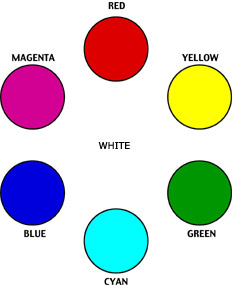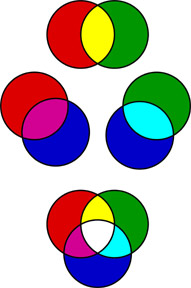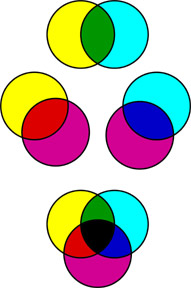|
Colored Light versus Colored Pigments
|
| The science of color is a fascinating study. This essay will explore the physics of colored light and colored pigments, and the color physiology of the human eye.
There are three primary colors of light: red, green and blue. Shining them at the same surface puts them together by addition, by adding them together. Mixing the primary colors produces the intermediate or secondary colors, yellow, cyan and magenta as in the diagram below. Equal quantitites of red and green light together are perceived as yellow. Blue and green light together are perceived as cyan. Blue and red light together are perceived as magenta. All the other perceived colors and shades of color can be produced by blending specific amounts of the primary colors. Mixing equal amounts of red, green and blue yields white light. White light can also be produced by mixing the proper proportion of a color and its opposite. Red and cyan, green and megenta, or blue and yellow light shined on the same area will appear as white light. For this reason, opposite colors are called complementary colors. Note that this white light appears white, but does not contain all the colors of the spectrum like, for example, sunlight. Full-spectrum white light is a combination of all the colors of the rainbow. Shine complete white light on a prism or upon water droplets in the air and you will see a rainbow of all the colors. The opaque pigments work differently. Pigments absorb light. The light they reflect is the color we perceive. Mixing pigments works by subtraction, by absorbing colors from the light that shines on them. When you have something printed at the print shop, the printer will usually mix magenta, yellow and cyan pigments to produce all the colors. Each color of pigment absorbs its opposite (complementary color) on the diagram below. Magenta pigment absorbs green light. Yellow pigment absorbs blue light. Cyan pigment absorbs red light. Transparent pigments work similarly, but instead of reflecting colors, they allow them to pass through. To make a pure red print color, blue and green have to be absorbed. Yellow absorbs blue and magenta absorbs green. So a mixture of yellow and magenta pigments will absorb all other colors and reflect red - thus creating the appearance of a red colored object. Similarly, mixing magenta (which absorbs green) and cyan (which absorbs red) yields a blue color. Mixing cyan (which absorbs red) and yellow (which absorbs blue) yields a green color. |
 |
 |
Mixing Colored Light
Red and Green light yields Yellow Red and Blue light yields Magenta Green and Blue light yields Cyan Equal mixtures of Red, Green and Blue yields White |
|
Colors of Light
|
The primary colors of light are red, blue and green. |
|
|
|
|
Mixing Pigment Colors
Yellow plus Cyan yields Green Yellow plus Magenta yields Red Cyan plus Magenta yields Blue Equal quantities of Yellow, Cyan and Magenta yields Black |
 |
|
The primary pigment colors are yellow, magenta and cyan.
|
Pigment Colors
|
|
|
|
| The Physiological Color Cube |